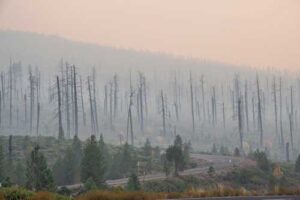Information provided by Rob Roloson, AGC Safety Management Consultant

As with many Oregon OSHA rules, training employees is required before employees are exposed, and on an annual basis thereafter. Training must include:
- Symptoms and health effects of wildfire exposure
- How to report health issues and obtain medical treatment if overexposed
- How to obtain current Air Quality Index (AQI) information
- The importance, limitations, and benefits of using a filtering facepiece respirator
- The employer’s methods to protect employees from wildfire smoke including a description of the employer’s two-way communication system
Employees can obtain current and forecasted Air Quality Index (AQI) information by accessing the U.S. EPA AirNow website, the Oregon DEQ air quality website, or the Weather App on most smartphones. In the event you cannot access AQI information (out of cell network, for instance), the rule allows employees to use the 5-3-1 visibility index.
An employer must consider engineering and administrative controls when managing work in areas impacted by wildfire smoke. This may include allowing workers to take breaks in vehicles where the air is adequately filtered, temporarily relocating workers to another jobsite, or changing employee work schedules to a time when better air quality is forecasted. Communication is also key. Employers must have a method of communicating that allows both sending and receiving information. Cell phones or two-way radios are examples of this two-way communication.
Employers must also provide employees who work outdoors with NIOSH-approved filtering facepieces (N-95 at a minimum) for voluntary use when the AQI reaches 101. When the AQI reaches 277, employers must require the use of filtering facepiece respirators for employees who work outdoors. When these respirators are used strictly for protection against wildfire smoke, the employer may implement and follow the Wildfire Smoke Respiratory Protection Program instead of conducting medical evaluations and fit testing. If AQI reaches 849 and above, NIOSH-approved respirators are mandatory and full implementation of the Respiratory Protection Standard is required.
Having a plan in place before there is a need can help protect workers, save time and budget, and keep projects moving smoothly despite the air quality. Prepare for the worst and hope for the best.